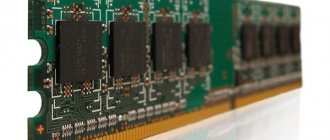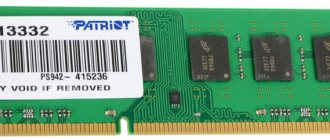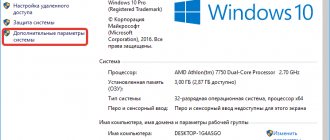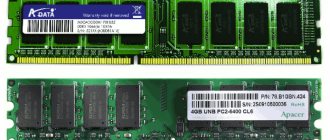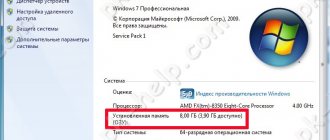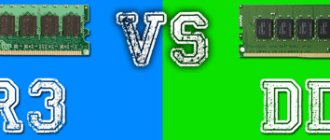When assembling a computer, be it for office or gaming, users first of all pay attention to the choice of processor, drives, motherboard and other components. And this is certainly correct. But if then, when choosing RAM, the buyer does not pay as much attention to it, then the potential of the rest of the hardware may not be revealed to 100%. And already at this stage a problem may arise, because it is not enough to take one or several large-volume planks, hoping that this will be enough. Therefore, we not only decided to find out which is the best DDR4 RAM 2019-2020 available on sale today, but also to give valuable tips on purchasing it.
Recommended Memory
For those who do not have time to read the entire article, I will immediately give recommendations on brands, memory capacity and frequency, depending on the purpose of the computer.
Buy memory from reputable brands: Corsair, Crucial, HyperX. It is not much more expensive, but much better quality. Among the more budget brands we can recommend: AMD, GeIL, Goodram, G.Skill, Team, Transcend.
For an office computer, one 4 GB DDR4 stick with a frequency of 2400 or 2666 MHz is enough (costs almost the same). RAM Crucial CT4G4DFS824A For a multimedia computer (movies, simple games), it is better to take two 4 GB DDR4 sticks with a frequency of 2666 MHz, then the memory will work in a faster dual-channel mode. RAM Ballistix BLS2C4G4D240FSB For a mid-class gaming computer, you can take one 8 GB DDR4 stick with a frequency of 2666 MHz so that in the future you can add another one, and it would be better if it is a simpler running model. RAM Crucial CT8G4DFS824A And for a powerful gaming or professional PC you need to immediately take a set of 2 DDR4 8 GB sticks, and a frequency of 2666 MHz will be quite sufficient. RAM Corsair CMK16GX4M2A2400C16 If you want to understand why I recommend this kind of memory, to understand all the nuances and technical characteristics of RAM, then read the article further.
You can download recommended PC configurations (processor + video card + memory) for games and video editing in the “Links” section.
The best DDR4 High-End memory
We decided to devote the last category in the RAM rating to top-end kits. And what requirements can be presented to such modules? Of course, they must be fast, reliable, cool and beautiful. In the first case, the important parameters are timings and frequency, which in each of the two sets discussed below is 3200 MHz. By the way, both sets include not two, but 4 sticks with a capacity of 8 GB. What about the design? An attractive radiator is clearly not enough here. But if the bars have customizable RGB backlighting, then your computer will sparkle with other colors (especially if it has other components with this option).
Corsair CMT32GX4M4C3200C16
When gamers want to buy RAM for their gaming PC, they often look at products from Corsair. Reliable, fast and stylish - this is what is typical for any RAM model from a well-known American manufacturer. If we talk specifically about the CMT32GX4M4C3200C16 variant, then this is a new product on the RAM market. If necessary, the user can overclock the chips above the standard frequency of 3200 MHz, but the nominal timings of 16-18-18-36 will deteriorate in this case. At the same time, you will get almost no performance gain in games, so there is no point in such experiments.
To adjust the backlight, the user can use a proprietary utility. It allows you to adjust the backlighting of memory modules in accordance with other products of the brand. If you don’t need this option, you can choose a separate color and even a glow option for each strip. At the same time, pay attention to whether this kit will fit your board and your case, because it has quite high and wide radiators.
Advantages:
- excellent characteristics;
- overclocking potential;
- ease of backlight settings;
- magnificent appearance;
- radiator efficiency.
G.SKILL F4-3200C16Q-32GTZR
The rating is completed by the best priced DDR4 memory in the high-end segment. It can be found for about 20 thousand rubles, which is quite good, considering the stated characteristics. Its only problem is availability, because at the beginning of 2020 this kit can only be purchased in a few online stores.
If you could not find the kit in question in your city, then you can purchase options with fewer strips. Sets of 2 modules of 8 GB are more common. In addition, frequencies of 3466 MHz and higher are available for them.
One of the main advantages of this RAM, according to user reviews, is the backlight. It perfectly complements the standard TridentZ design. In addition, in the proprietary utility the user can configure the glow separately for each bar, choosing between 16.7 million shades, which looks simply great.
Advantages:
- timings 16-18-18-36;
- there is XMP support;
- number and design of modules;
- frequency 3200 MHz and overclocking capability;
- attractive price for its capabilities.
Flaws:
- It is very difficult to find a 32 GB kit on sale.
How much memory do you need?
For an office computer designed for working with documents and accessing the Internet, one 4 GB memory stick is sufficient.
For a multimedia computer that can be used to watch high-quality videos and undemanding games, 8 GB of memory is sufficient.
For a mid-range gaming computer, the minimum option is 8 GB of RAM.
A powerful gaming or professional computer requires 16 GB of memory.
A larger amount of memory may be needed only for very demanding professional programs and is not needed by ordinary users.
Memory capacity for older PCs
If you decide to increase the memory on your old computer, be aware that 32-bit versions of Windows do not support more than 3 GB of RAM. That is, if you install 4 GB of RAM, the operating system will see and use only 3 GB.
As for 64-bit versions of Windows, they will be able to use all the installed memory, but if you have an old computer or an old printer, then they may not have drivers for these operating systems. In this case, before purchasing memory, install the 64-bit version of Windows and check if everything works for you. I also recommend looking at the website of the motherboard manufacturer and seeing what volume of modules and total amount of memory it supports.
Please also note that 64-bit operating systems consume 2 times more memory, for example, Windows 7 x64 takes about 800 MB for its needs. Therefore, 2 GB of memory for such a system will not be enough, preferably at least 4 GB.
Practice shows that modern operating systems Windows 7,8,10 are fully operational with a memory capacity of 8 GB. The system becomes more responsive, programs open faster, and jerks (freezes) disappear in games.
Memory types
Modern memory is of the DDR SDRAM type and is constantly being improved. So DDR and DDR2 memory is already obsolete and can only be used on older computers. DDR3 memory is no longer advisable to use on new PCs; it has been replaced by the faster and more promising DDR4.
Please note that the selected memory type must be supported by the processor and motherboard.
Also, new processors, for compatibility reasons, can support DDR3L memory, which differs from regular DDR3 in reduced voltage from 1.5 to 1.35 V. Such processors will be able to work with regular DDR3 memory if you already have it, but processor manufacturers do not recommend this because -due to increased degradation of memory controllers designed for DDR4 with an even lower voltage of 1.2 V.
Memory type for older PCs
Outdated DDR2 memory costs several times more than more modern memory. A 2 GB DDR2 stick costs 2 times more, and a 4 GB DDR2 stick costs 4 times more than a DDR3 or DDR4 stick of the same size.
Therefore, if you want to significantly increase the memory on an old computer, then perhaps the best option would be to switch to a more modern platform by replacing the motherboard and, if necessary, a processor that will support DDR4 memory.
Calculate how much it will cost you; perhaps a profitable solution would be to sell the old motherboard with old memory and purchase new, albeit not the most expensive, but more modern components.
RAM kits on selected chips with a total capacity of 32 GB
Again, exclusively on Samsung B-die memory chips.
G.SKILL Ripjaws V F4-3200C14D-32GVK. Timings 14-14-14-34. The average price is 23,000 rubles. It can be easily overclocked, like other kits with similar characteristics.
G.SKILL Trident Z F4-4000C19D-32GTZKK. Timings 19-19-19-39. The average price is 30,000 rubles. Don't forget to activate the XMP profile in the motherboard BIOS.
Please note that 4000 MHz, as well as 4400 MHz, is a fairly high frequency for RAM, and not every motherboard and processor will be able to work stably with such values.
Memory Specifications
The main characteristics of memory on which its performance depends are frequency and timings. Memory speed does not have as strong an impact on the overall performance of the computer as the processor. However, you can often get faster memory for not much more. Fast memory is needed primarily for powerful professional computers.
5.1. Memory frequency
Frequency has the greatest impact on memory speed. But before purchasing it, you need to make sure that the processor and motherboard also support the required frequency. Otherwise, the actual memory operating frequency will be lower and you will simply overpay for something that will not be used.
Inexpensive motherboards support lower maximum memory frequencies, for example for DDR4 it is 2400 MHz. Mid-range and high-end motherboards can support higher frequency memory (3400-3600 MHz).
But with processors the situation is different. Older processors with DDR3 memory support may support memory with a maximum frequency of 1333, 1600, or 1866 MHz (depending on the model). For modern processors that support DDR4 memory, the maximum supported memory frequency may be 2400 MHz or higher.
Intel 6th generation and higher processors and AMD Ryzen processors support DDR4 memory at 2400 MHz or higher. Moreover, their lineup includes not only powerful expensive processors, but also mid-range and budget-class processors. Thus, you can build a computer on the most modern platform with an inexpensive processor and DDR4 memory, and in the future change the processor and get the highest performance.
The main memory today is DDR4 2400 MHz, which is supported by the most modern processors, motherboards and costs the same as DDR4 2133 MHz. Therefore, purchasing DDR4 memory with a frequency of 2133 MHz today does not make sense.
You can find out what memory frequency a particular processor supports on the manufacturers’ websites:
By model number or serial number it is very easy to find all the characteristics of any processor on the website:
Or simply enter the model number in the Google or Yandex search engine (for example, “Ryzen 7 1800X”).
5.2. High Frequency Memory
Now I want to touch on another interesting point. On sale you can find RAM at a much higher frequency than any modern processor supports (3000-3600 MHz and higher). Accordingly, many users are wondering how this can be?
It's all about a technology developed by Intel, eXtreme Memory Profile (XMP). XMP allows memory to run at a higher frequency than the processor officially supports. XMP must be supported by both the memory itself and the motherboard. High frequency memory simply cannot exist without support for this technology, but not all motherboards can boast of its support. These are mainly more expensive models above the middle class.
The essence of XMP technology is that the motherboard automatically increases the frequency of the memory bus, due to which the memory begins to operate at its higher frequency.
AMD has a similar technology called AMD Memory Profile (AMP), which was supported by older AMD processor motherboards. These motherboards usually also supported XMP modules.
Purchasing more expensive memory with a very high frequency and a motherboard with XMP support makes sense for very powerful professional computers equipped with a top-end processor. In a middle-class computer, this will be wasted money, since everything will depend on the performance of other components.
In games, the memory frequency has a small impact and there is no point in overpaying; it will be enough to go for 2400 MHz, or 2666 MHz if the difference in price is small.
For professional applications, you can take memory with a higher frequency - 2666 MHz or, if you want and have funds, 3000 MHz. The difference in performance here is greater than in games, but not dramatic, so there is no particular point in pushing the memory frequency.
Let me remind you once again that your motherboard must support memory at the required frequency. In addition, sometimes Intel processors become unstable at memory frequencies above 3000 MHz, and for Ryzen this limit is around 2900 MHz.
5.3. Timings
Timings are the delays between read/write/copy operations of data in RAM. Accordingly, the fewer these delays, the better. But timings have a much smaller impact on memory speed than its frequency.
There are only 4 main timings that are indicated in the characteristics of memory modules.
Of these, the most important is the first number, which is called latency (CL).
Typical latency for DDR3 1333 MHz memory is CL 9, for higher frequency DDR3 memory is CL 11.
Typical latency for DDR4 2133 MHz memory is CL 15, for DDR4 memory with higher frequencies is CL 16.
You should not purchase memory with a latency higher than specified, as this indicates an overall low level of its technical characteristics.
Typically, memory with lower timings is more expensive, but if the price difference is not significant, then memory with lower latency should be preferred.
5.4. Supply voltage
Memory may have different supply voltages. It can be either standard (generally accepted for a certain type of memory), or increased (for enthusiasts) or, conversely, reduced.
This is especially important if you want to add memory to your computer or laptop. In this case, the voltage of the new strips should be the same as the existing ones. Otherwise, problems are possible, since most motherboards cannot set different voltages for different modules.
If the voltage is set to a level with a lower voltage, then others may not have enough power and the system will not work stably. If the voltage is set to a level with a higher voltage, then the memory designed for a lower voltage may fail.
If you are building a new computer, then this is not so important, but to avoid possible compatibility problems with the motherboard and replacing or expanding memory in the future, it is better to choose sticks with a standard supply voltage.
The memory, depending on the type, has the following standard supply voltages:
- DDR - 2.5 V
- DDR2 - 1.8 V
- DDR3 - 1.5 V
- DDR3L - 1.35 V
- DDR4 - 1.2 V
I think you noticed that there is DDR3L memory in the list. This is not a new type of memory, but regular DDR3, but with a reduced supply voltage (Low). This is the kind of memory needed for 6th generation Intel processors and higher, which support both DDR4 and DDR3 memory. But in this case, it is better to build the system on new DDR4 memory.
What to look for when choosing RAM
- Of course, volume is important. It should not be too small, because in theory you can work with 4 GB, but several extensions and tabs in Chrome running along with office applications will show you how inconvenient it is. But you shouldn’t install too much either. Even with a huge budget.
- For example, the Home edition of Windows 10 supports up to 128 GB of RAM. But, firstly, it is almost impossible to find such a volume with one set, and secondly, it is difficult for us to imagine situations in which you will be able to fill it by at least a third. Therefore, you won’t find 64 GB kits in our review either.
- The number of slats also plays a role. For fast work, one module is no longer enough. But two are still enough for almost any task. If you need maximum performance in games or you work in professional software, then you should take a closer look at sets with four brackets.
- The next important points are frequencies and timings. Both parameters affect the speed of operation of the modules, and are inversely related to each other. That is, the lower the delay, the lower the frequency that will be supported with it. To put it simply: the lower the timings, the faster the processor accesses memory cells. Frequency affects the speed of information transfer for processing.
- The last important point is cooling efficiency. It depends on the radiator used by the manufacturer. It also affects the design of RAM, but this is a secondary issue and depends on your preferences. But the cooling must be of high quality, because at high performance the chips will overheat. Therefore, all modern RAM models, if they are not the simplest ones, contain radiators.
Memory module markings
Memory modules are marked depending on the type of memory and its frequency. The marking of DDR memory modules begins with PC, followed by a number indicating the generation and speed in megabytes per second (MB/s).
Such markings are inconvenient to navigate; it is enough to know the type of memory (DDR, DDR2, DDR3, DDR4), its frequency and latency. But sometimes, for example on ad sites, you can see markings copied from the strip. Therefore, so that you can get your bearings in this case, I will give the markings in a classic form, indicating the type of memory, its frequency and typical latency.
DDR - obsolete
- PC-2100 (DDR 266 MHz) - CL 2.5
- PC-2700 (DDR 333 MHz) - CL 2.5
- PC-3200 (DDR 400 MHz) - CL 2.5
DDR2 - obsolete
- PC2-4200 (DDR2 533 MHz) - CL 5
- PC2-5300 (DDR2 667 MHz) - CL 5
- PC2-6400 (DDR2 800 MHz) - CL 5
- PC2-8500 (DDR2 1066 MHz) - CL 5
DDR3 - obsolete
- PC3-10600 (DDR3 1333 MHz) - CL 9
- PC3-12800 (DDR3 1600 MHz) - CL 11
- PC3-14400 (DDR3 1866 MHz) - CL 11
- PC3-16000 (DDR3 2000 MHz) - CL 11
DDR4 - the most modern
- PC4-17000 (DDR4 2133 MHz) - CL 15
- PC4-19200 (DDR4 2400 MHz) - CL 16
- PC4-21300 (DDR4 2666 MHz) - CL 16
- PC4-24000 (DDR4 3000 MHz) - CL 16
- PC4-25600 (DDR4 3200 MHz) - CL 16
DDR3 and DDR4 memory may have a higher frequency, but only top processors and more expensive motherboards can work with it.
Memory module design
Memory sticks can be single-sided, double-sided, with or without radiators.
7.1. Chip placement
Chips on memory modules can be placed on one side of the board (single-sided) or on both sides (double-sided).
This doesn't matter if you are purchasing memory for a new computer. If you want to add memory to an old PC, then it is advisable that the arrangement of chips on the new stick be the same as on the old one. This will help avoid compatibility issues and increase the likelihood of memory operating in dual-channel mode, which we will talk about later in this article.
7.2. Memory with heatsinks
Now on sale you can find many memory modules with aluminum radiators of various colors and shapes.
The presence of heatsinks can be justified on DDR3 memory with a high frequency (1866 MHz or more), since it heats up more. At the same time, ventilation must be well organized in the housing.
Modern DDR4 RAM with a frequency of 2400, 2666 MHz practically does not heat up and the radiators on it will be purely decorative. They can even get in the way, because after a while they become clogged with dust, which is difficult to clean out of them. In addition, such memory will cost somewhat more. So, if you want, you can save on this, for example, by taking excellent Crucial 2400 MHz memory without heatsinks.
Memory with a frequency of 3000 MHz or more also has an increased supply voltage, but it also does not heat up very much and in any case there will be heatsinks on it.
Timings
There were already a few words about timings on the site, but since this was a long time ago, we’ll go through them again.
In other words, they represent time delays or latency (CAS Latency, CL) of the RAM. This value is indicated in the form of several consecutive numbers (for example, 3-3-3). These are the following parameters recorded in a row: “CAS Latency” (duty cycle time), “RAS to CAS Delay” (full access time) and “RAS Precharge Time”. The throughput of the “processor-memory” section and, as a consequence, the performance of the entire system largely depends on them. The smaller the value of these timings, the faster the RAM works. Timings are measured in nanoseconds (ns) and can take a value from 2 to 9 (each number is the number of bus cycles to perform a particular operation).
Sometimes a fourth parameter is added to these three parameters (for example, 9-9-9-27), called “DRAM Cycle Time Tras/Trc” (characterizes the performance of the entire memory chip).
If only one number is indicated (for example, CL2), then it means only the first parameter - CAS Latency, the rest are not necessarily equal to it, but usually even higher, so keep this in mind and do not fall for the manufacturer’s marketing ploy.
Lower values mean faster performance. True, there is one problem: the higher the RAM frequency, the higher its timings, and therefore, you should choose the optimal ratio of these two parameters, based on the budget. For example, there are special models from different manufacturers, the notes to which indicate “Low Latency”. This means that this model, at a higher operating frequency, has shorter delay times, but they are much more expensive.
Let’s summarize the timing epic: when purchasing, it is better to choose memory with the lowest timings, and if you want to add a module to an already installed one, then the CL of this memory should match the timings of the already installed one.
Memory for laptops
Memory for laptops differs from memory for desktop computers only in the size of the memory module and is labeled SO-DIMM DDR. Just like for desktop computers, memory for laptops has types DDR, DDR2, DDR3, DDR3L, DDR4.
In terms of frequency, timings and supply voltage, memory for laptops does not differ from memory for computers. But laptops only come with 1 or 2 memory slots and have stricter maximum capacity limits. Be sure to check these parameters before choosing memory for a specific laptop model.
Memory operating modes
The memory can operate in Single Channel, Dual Channel, Triple Channel or Quad Channel mode.
In single-channel mode, data is written sequentially to each module. In multi-channel modes, data is written in parallel to all modules, which leads to a significant increase in the speed of the memory subsystem.
Single-channel memory mode is limited only to hopelessly outdated motherboards with DDR memory and the first models with DDR2.
All modern motherboards support dual-channel memory mode, while three-channel and quad-channel modes are supported only by a few models of very expensive motherboards.
The main condition for dual-channel mode operation is the presence of 2 or 4 memory sticks. Three-channel mode requires 3 or 6 memory sticks, and four-channel mode requires 4 or 8 memory sticks.
It is desirable that all memory modules are the same. Otherwise, dual-channel operation is not guaranteed.
If you want to add memory to an old computer and your motherboard supports dual-channel mode, try to choose a stick that is as identical in all respects as possible. It is best to sell the old one and buy 2 new identical strips.
In modern computers, memory controllers have been moved from the motherboard to the processor. Now it is not so important that the memory modules are the same, since the processor will still be able to activate dual-channel mode in most cases. This means that if in the future you want to add memory to a modern computer, you will not necessarily need to look for exactly the same module; you just need to choose the one that is most similar in characteristics. But I still recommend that the memory modules be the same. This will give you a guarantee of its fast and stable operation.
With the transfer of memory controllers to the processor, 2 more modes of dual-channel memory operation appeared - Ganged (paired) and Unganged (unpaired). If the memory modules are the same, the processor can work with them in Ganged mode, as before. If the modules differ in characteristics, the processor can activate the Unganged mode to eliminate distortions in working with memory. In general, the memory speed in these modes is almost the same and makes no difference.
The only downside to dual-channel mode is that multiple memory modules are more expensive than one of the same size. But if you are not very strapped for money, then buy 2 sticks, the memory speed will be much higher.
If you need, say, 16 GB of RAM, but you can’t afford it yet, then you can buy one 8 GB stick so that you can add another one of the same kind in the future. But it is still better to purchase two identical strips at once, since later you may not be able to find the same one and you will encounter a compatibility problem.
Memory module manufacturers
One of the best price/quality ratios today comes from the memory of the impeccably proven Crucial brand, which has modules from budget to gaming (Ballistix).
Competing with it is the well-deserved Corsair brand, whose memory is somewhat more expensive.
As an inexpensive but high-quality alternative, I especially recommend the Polish brand Goodram, which has bars with low timings at a low price (Play line).
For an inexpensive office computer, simple and reliable memory made by AMD or Transcend will be sufficient. They have proven themselves to be excellent and there are practically no problems with them.
In general, the Korean companies Hynix and Samsung are considered leaders in memory production. But now modules of these brands are mass-produced in cheap Chinese factories, and among them there are a lot of fakes. Therefore, I do not recommend purchasing memory from these brands.
An exception may be Hynix Original and Samsung Original memory modules, which are manufactured in Korea. These strips are usually blue, their quality is considered better than those made in China and the guarantee for them is slightly higher. But in terms of speed characteristics, they are inferior to memory with lower timings from other quality brands.
Well, for enthusiasts and fans of modding there are affordable overclocking brands GeIL, G.Skill, Team. Their memory has low timings, high overclocking potential, an unusual appearance and costs a little less than the well-promoted Corsair brand.
There is also a wide range of memory modules on sale from the very popular manufacturer Kingston. Memory sold under the budget Kingston brand has never been of high quality. But they have a top-end HyperX series, which is deservedly popular, which can be recommended for purchase, but is often overpriced.
I do not recommend purchasing memory modules from brands and manufacturers not listed here, whose products are represented by only a few models.
The best DDR4 modules for price and quality
The reduction in cost has had a positive impact not only on the budget segment, where you can now purchase excellent solutions for office, as well as basic and optimal gaming computers, but also on the mid-price category. For a reasonable price you can find fast and reliable RAM for demanding tasks. In this group we will also look at four sets of memory, two of which will be faster, but smaller in size (16 GB), and the second pair will be slightly slower, but larger (32 GB).
HyperX HX432C18FBK2/32
If the user doesn’t want to think for a long time about which DDR4 memory is better, and just needs to buy a reliable RAM for a reasonable price, then the HX432C18FBK2 will be one of the best options to buy. With a nominal frequency of 3200 MHz, this RAM has a timing scheme of 18-21-21. Yes, such values cannot be called impressive, but it is necessary to take into account the price tag below 15,000 rubles, which the manufacturer set for a 32 GB set.
If you cannot allocate the required amount to purchase the entire set, then you can purchase a 16 GB HX432C18FB module, and then, when the required amount appears, buy another one of the same kind. Yes, in the end the costs will be a little higher, but with a limited budget this approach is quite reasonable.
In appearance, the RAM is similar to other representatives of the line. The memory chips used by the company are no different: 16-nanometer E-Dies manufactured by Micron. In standard mode, the strips consume 1.2 V. The RAM throughput is 25,600 megabytes/sec.
Advantages:
- support for Kingston PnP technology;
- good amount of memory;
- operates at a frequency of 3200 MHz;
- work without increased stress;
- overclocking capabilities (in theory).
Flaws:
- high delays.
G.SKILL F4-3200C14D-16GVK
Next up is high-quality memory from G.SKILL, built on top-end B-Die chips from Samsung. And, looking at the nominal timing values 14-14-14-34, users are unlikely to doubt the veracity of this statement. The kit contains two memory sticks of 8 GB each, capable of operating at a frequency of 3200 MHz with standard presets. If you specify higher timings, you will be able to set a higher operating frequency. However, this is only advisable with an AMD Ryzen CPU.
Advantages:
- standard operating parameters;
- excellent overclocking capabilities;
- attractive appearance;
- versions available in other colors.
Flaws:
- bulky radiator.
Corsair CMK32GX4M2B3000C15
Typically, Corsair products are significantly more expensive than their competitors. And, it would seem, this is explained by excellent quality and reliability, but still not all consumers agree to pay impressive money for RAM. Therefore, it is especially pleasant to mention the CMK32GX4M2B3000C15 RAM in the review. If you have the necessary knowledge, then all the characteristics of this kit can be understood from the name. So, it includes two sticks with a capacity of 16 GB each and can operate at a standard frequency of 3000 MHz with latencies of 15-17-17-35. The voltage consumption in this case is 1.35 V.
Advantages:
- duration of warranty;
- impressive performance;
- excellent combination of price and quality;
- good for overclockers;
- beautiful radiators with a small height.
G.SKILL F4-3600C16D-16GTZ
The leader in the TOP of DDR4 RAM in terms of cost and quality ratio is another excellent model G.SKILL. This is an expensive kit that includes only two 16 GB sticks. But it can boast of good throughput of 28800 MB/s and good timings of 16-16-16-36. Moreover, the operating frequency of the RAM in this case will be an impressive 3600 MHz, which is the best value in the review.
G.SKILL TridentZ is an extensive line that includes a huge number of models. One of the best RAMs in terms of reliability is offered in sets of two to eight modules with capacities of 4-16 GB each. The frequency range of each of the strips can be equal to, respectively, 2800-4400 MHz at voltages of 1.25-1.5 V. Of course, we will not be able to cover them all in one review, so consider alternative solutions yourself, because among them you may find a suitable one to you.
But that's not all! Having the best combination of price and quality, RAM also boasts an excellent appearance. Beautiful radiators with several color options will surely decorate any computer. However, please note that due to the height of passive cooling, you will not be able to install some models of processor coolers next to these brackets.
Advantages:
- attractive appearance;
- reasonable cost;
- decent work speed;
- the best RAM frequency in the ranking;
- two XMP profiles for easy setup.
Flaws:
- radiator size.
Increase memory
If you are planning to add memory to an existing computer or laptop, then first find out what the maximum memory capacity and total memory capacity is supported by your motherboard or laptop.
Also check how many memory slots are on the motherboard or laptop, how many of them are occupied and what kind of memory sticks are installed in them. It's better to do it visually. Open the case, take out the memory sticks, examine them and write down all the characteristics (or take a photo).
If for some reason you don’t want to get into the case, you can view the memory parameters in the program on the SPD tab. This way you won't know if the stick is single-sided or double-sided, but you can find out the memory characteristics if there is no sticker on the stick.
There is a base and effective memory frequency. The CPU-Z program and many similar ones show the base frequency, it must be multiplied by 2.
Once you know how much memory you can increase, how many free slots are available, and what kind of memory you have installed, you can begin to explore the possibilities of increasing memory.
If all memory slots are occupied, then the only way to increase memory is to replace existing memory sticks with new ones of larger capacity. And old planks can be sold on an advertisement site or exchanged at a computer store when purchasing new ones.
If there are free slots, then you can add new memory sticks to the existing ones. In this case, it is desirable that the new strips be as close as possible to the characteristics of those already installed. In this case, you can avoid various compatibility problems and increase the chances that the memory will work in dual-channel mode. To do this, the following conditions must be met, in order of importance.
- The memory type must match (DDR, DDR2, DDR3, DDR3L, DDR4).
- The supply voltage for all strips must be the same.
- All planks must be single-sided or double-sided.
- The frequency of all bars must match.
- All strips must be of the same volume (for dual-channel mode).
- The number of strips must be even: 2, 4 (for dual-channel mode).
- It is desirable that the latency (CL) matches.
- It is desirable that the strips are from the same manufacturer.
The easiest place to start choosing is with the manufacturer. Choose in the online store catalog strips of the same manufacturer, volume and frequency as installed in yours. Make sure that the supply voltage matches and check with your consultant whether they are single-sided or double-sided. If the latency also matches, then generally good.
If you were unable to find strips from the same manufacturer with similar characteristics, then choose all the others from the list of recommended ones. Then again look for strips of the required volume and frequency, check the supply voltage and check whether they are single-sided or double-sided. If you are unable to find similar planks, then look in another store, catalog or ad site.
The best option is always to sell all the old memory and buy 2 new identical sticks. If the motherboard does not support the brackets of the required volume, you may have to buy 4 identical brackets.
Setting up filters in an online store
- Go to the “RAM” section on the seller’s website.
- Select recommended manufacturers.
- Select the form factor (DIMM - PC, SO-DIMM - laptop).
- Select the memory type (DDR3, DDR3L, DDR4).
- Select the required volume of slats (2, 4, 8 GB).
- Select the maximum frequency supported by the processor (1600, 1866, 2133, 2400 MHz).
- If your motherboard supports XMP, add higher frequency memory (2666, 3000 MHz) to the selection.
- Sort the selection by price.
- Consistently look through all items, starting with the cheapest ones.
- Select several strips that match the frequency.
- If the price difference is acceptable to you, take sticks with a higher frequency and lower latency (CL).
Thus, you will get the optimal price/quality/speed ratio of memory at the lowest possible cost.
Which DDR4 memory kit to buy
Let's start with the top solutions. In terms of characteristics, they have worthy competitors in the middle price segment. And it would be more rational to take them if you consider RGB lighting an unnecessary option. Do you want to save money? Then consider the best DDR4 RAM options in the budget segment. The best option for memory kits would be products from HyperX and G.SKILL, they also distinguished themselves in the price-quality category. Moreover, in the latter case, the available models are both faster and more capacious, which allows you to choose a RAM that meets your needs at the same cost.
